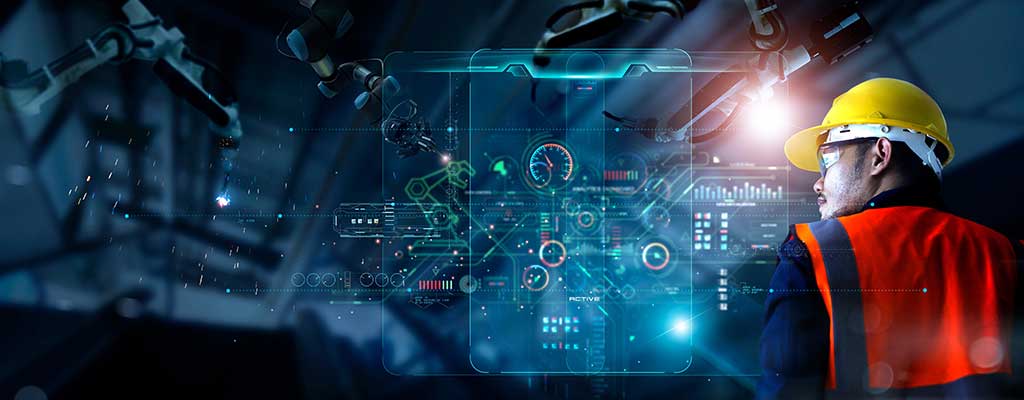
TE Perspectives
The Growing Role of Cobots in Factory Automation
Author: Alex Megej, VP & CTO, Connected Living Solutions
Although robots have been a fixture in the industrial landscape for decades, technological innovations are driving a new wave of factory automation. The emergence of collaborative robots, or cobots, as well as cobot-sized smaller robots is bringing new levels of efficiency and productivity to smaller businesses that can’t afford (and don’t need) the capabilities of industrial robots.
Cobots are smaller, cheaper, and easier to program than traditional industrial robots — and they are much more flexible. A modern robot can be quickly reassigned to perform new tasks as needed, or moved to a different area of a factory or warehouse. Cobots are also designed to operate safely alongside people, making them well suited for dangerous or repetitive tasks, or to assist human operators in tasks that require extreme precision.
It’s no surprise, then, that those cobots are one of the fastest-growing segments of the robotics industry. Worldwide cobot shipments are expected to pass 47,000 annually by 2026, up from 10,000 in 2021 [1], a growth rate above the projected growth for industrial robots [2].
To help cobot designers meet this demand, TE Connectivity focuses on key trends shaping the future of factory automation: Increased flexibility, lower total cost of ownership, enhanced safety, and durability.

Collaborative Robots: Creating One Machine to Perform Multiple Tasks
Unlike industrial robots, which are designed to perform the same task repeatedly for decades, a single cobot must be adaptable for multiple jobs. For example, a company might need a cobot that can easily transition from a simple pick-and-place task to a machine tending role that requires more precision.
The challenge for cobot designers is creating an arm that provides the range of motion required to complete different tasks, while still keeping costs down. Each potential movement requires a separate axis with its own set of motors, sensors, cables and connectors—which adds to the cost. For that reason, cobot manufacturers have settled on a standard, six-axis setup for flexible robots. This configuration mimics the range of motion in a human arm, making it suitable for most collaborative tasks.
Yet within this standard setup, designers must still balance the competing needs for durability, sensitivity and cost when choosing internal components. For example, resolvers — systems measuring rotational angle — offer low cost and high durability, but may not offer the precision needed for fine tasks. At the other end of the spectrum, optical encoders can deliver higher precision but are more fragile and expensive. To help make cobots more accessible to a wide range of users, TE also offers a middle ground between these two options: Magnetic encoders that allow for greater precision than resolvers but are significantly less expensive and more robust than optical sensors.
Optimizing Factory Robots to Keep Human Workers Safe
By definition, cobots are designed to work alongside humans. They can be installed without safety cages, which helps keep installation costs down and reduces their footprint on the factory or warehouse floor. However, this configuration requires other safety features to protect nearby workers.
Advancements in torque sensors have helped make cobots safer and more reliable. Installed in each axis of the cobot arm, torque sensors measure the amount of mechanical strain within the axis motor and gearbox. They can be programmed to keep torque below a specific threshold, automatically shutting down before there’s a risk of injury to a human operator or damage to the cobot arm itself.
As cobot adoption continues to rise, we anticipate further improvements in other safety features such as proximity and absolute positioning sensors. By using a range of optical and pressure sensors, factory owners can build an invisible fence around cobots, which triggers the machines to either slow down or stop immediately when a human enters the workspace.

Robotics Reliability in Harsh Conditions
Reducing downtime and repair costs is essential to keeping cobots affordable, which presents a challenge because cobots typically operate in environments that aren’t friendly to electronic components and moving parts. Dust, moisture, oil, heat, vibration and electromagnetic interference are common in factories and warehouse settings.
That’s why TE designs our components like position and angular sensors specifically for these harsh conditions. But cobot designers often overlook another area where reliability is paramount: Cables and connectors.
The cables and connectors for axis components like sensors and motors are often housed inside the cobot arm itself. Even with this protection, it’s necessary to use industrial-grade cabling assemblies specifically designed to provide the range of motion needed for each arm joint while eliminating any unwanted movements as the arm performs its tasks repeatedly.
Connectivity gets even trickier when a task has to accommodate the variability in end-of-arm tooling and sensing. Switching between tasks often requires a new set of tools at the end of the cobot arm, including grippers, sensors, cameras and lights. Each of those components needs power and data connectivity outside the protection of the cobot arm.
Because adaptability is one of the main benefits of cobots, we’re focused on helping designers reduce complexity in their cabling and connectors while maintaining functionality. For example, we’re working on solutions that combine power and data connectivity in a single cable, such as Single-Pair Ethernet (SPE). This one cable provides enough power and data transfer rates for any end-of-arm peripherals.
Enabling the Factory Architecture of the Future
The rise of cobots has already brought new levels of automation into settings where it wasn’t practical or affordable just a few years ago. As cobots continue to take over more tasks, they will also help manufacturers optimize their production process for even greater efficiency and flexibility.
We see a future in which manufacturing floors are organized around modular cells, each offering the flexibility to switch between discreet tasks or custom processes. In addition, advancements in wireless connectivity will help facility owners monitor and analyze the performance of each of these semi-autonomous cells. At the same time, AI and Machine Learning will evolve to help cobots learn to perform new tasks more quickly.
These advancements in factory automation will help manufacturers adapt to the growing demand for speed, efficiency, and customization while also being part of a solution for other challenges like the ongoing labor shortage. Although the progression from semi-autonomous to fully autonomous production will take years, combining cobots with seamless connectivity and enhanced intelligence is the roadmap that will get us there.

About the Author

Alex Megej
Alex Megej is vice president and chief technology officer for TE Connectivity’s Connected Living Solutions business. He previously served as vice president and chief technology officer for TE’s Industrial business. Before joining TE in 2019, Alex worked in multiple industries and organizations, ranging from education and scientific institutions to start-up, mid-size, and multinational companies. With a background in sensor systems, microwave electronics, and semiconductors, Alex is an author who has published books and more than 40 peer-reviewed scientific papers. He is also named on several patents and patent applications. Alex earned his master’s degree in engineering and a Ph.D. from the University of Technology in Darmstadt and completed a business-administration program at IMD Lausanne, Switzerland. He is a Senior Member of the Institute of Electrical and Electronics Engineers (IEEE).
Insights on Factory Cobots and Industrial Robotics
Executive Insights: More stories on tech innovation
References
[1] https://www.abiresearch.com/press/more-than-47000-collaborative-robots-shipped-to-warehouses-by-2026-and-37-other-technology-stats-you-need-to-know/
[2] https://www.cobottrends.com/why-component-makers-should-target-cobots/


 e
e
 e
e
 e
e


